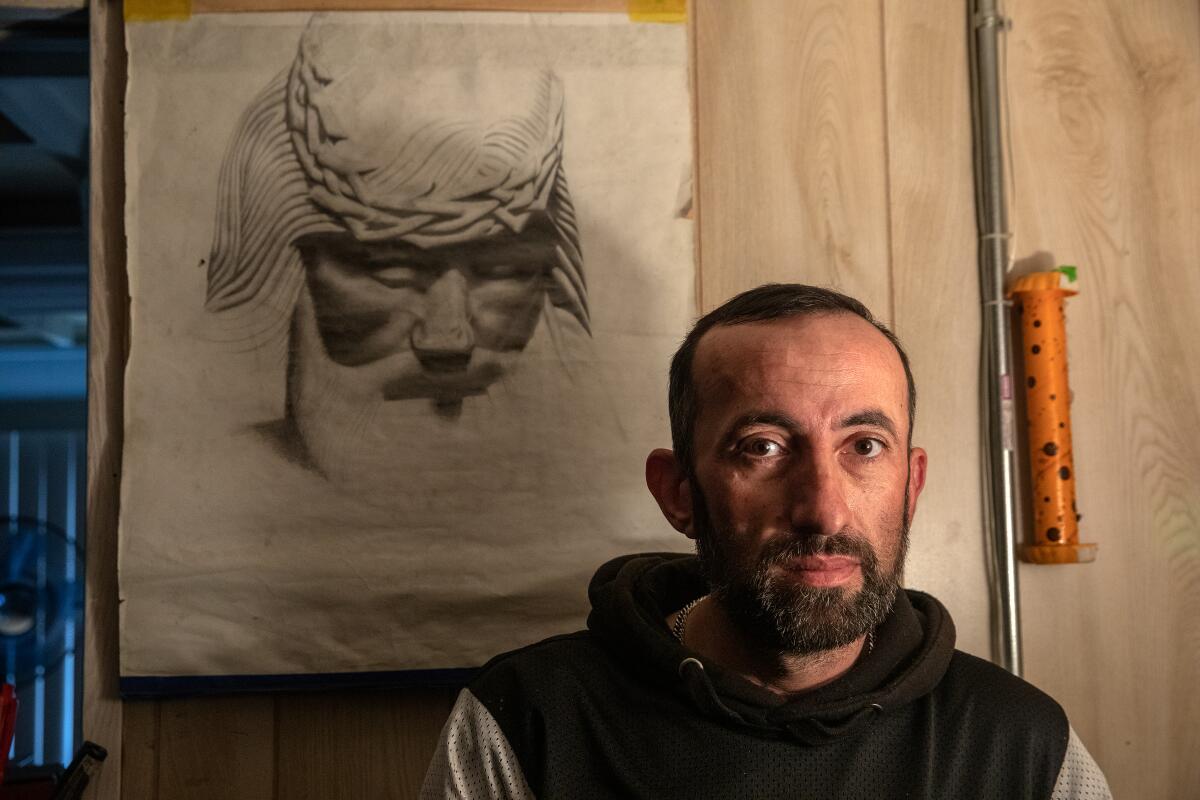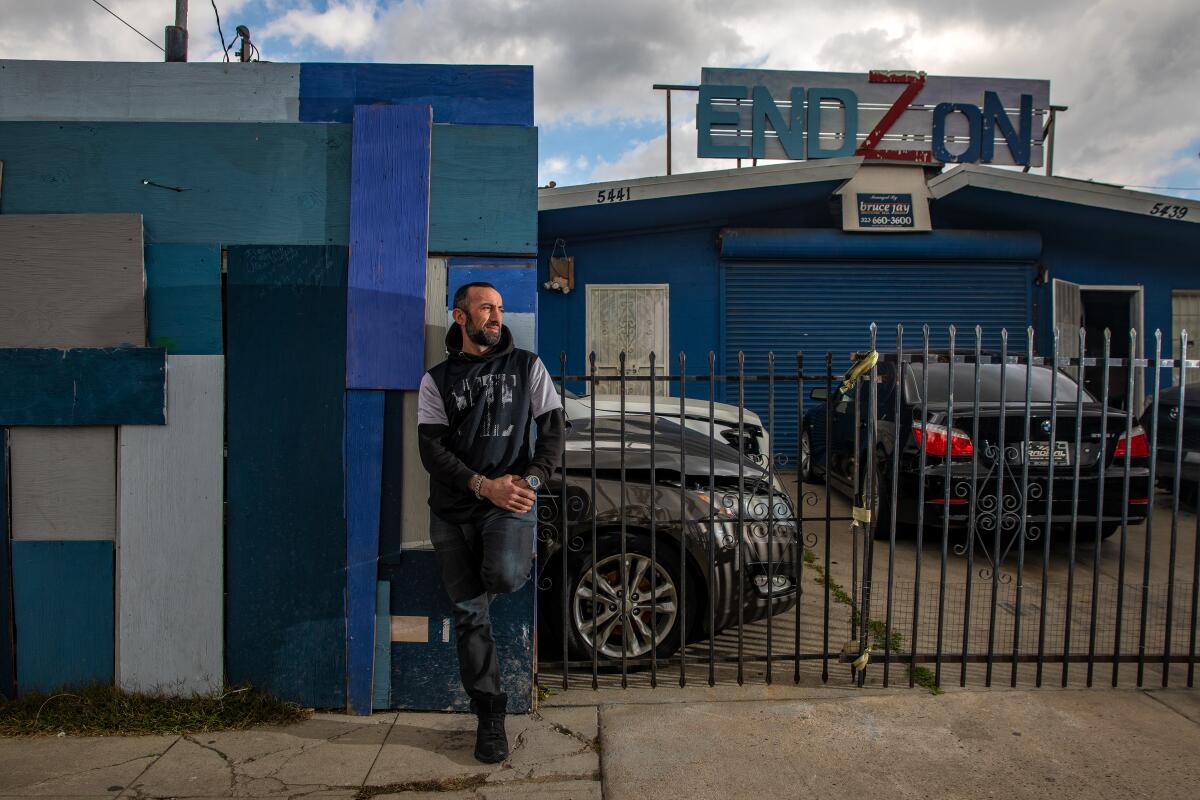Making art — and still making the mortgage — at a Hollywood auto body shop

- Share via
The first thing I noticed about the art piece near the corner of Fountain and Western avenues south of Hollywood was the color.
It was a collage of painted planks representing every shade of Southern California weather, cloudy white and misty blue next to rainy-day slate gray and the deep cerulean of midsummer. It reminded me of the abstract color blocking of the Dutch painter Piet Mondrian.
The second thing I noticed about the mosaic was that it served as a fence for a small auto body shop called EndZon Automotive.
I decided I wanted to meet the auto body mechanic who saw the sky with such an artistic eye. So I knocked on the door.
Michael Yeghish, 43, of Glendale had never heard of Mondrian, and aside from taking a pottery class in Armenia, he didn’t have any formal training as an artist.

He named his body shop EndZon because lots of other businesses were already named “end zone.” And he built the piece because he wanted to erect a fence after finding some needles and trash in his driveway. He found a contractor who cited a price he felt was exorbitant, so Yeghish decided to do it himself.
The project began as a fence, but he soon grew preoccupied with finding the right colors. He kept going back to Home Depot for more wood and paint. He wanted the business to look nice and thought of it as his territory. He planned to add lights and more signage to brand his business, but Yeghish is a busy man with a lot of projects, and soon he had to move on to the next one.
Most of his art is like that — a rest stop on the way to heavier concerns such as paying rent, carrying an expensive mortgage, or trying to construct a back unit to help afford said mortgage payments.
“I’m not — I don’t know any artist. But I just thought, to make a nice picture, you have to have in your vision nice colors. As long as the colors come together,” Yeghish said.
It was a reminder that people like Yeghish, who emigrated from Armenia in 1997 when he was in his 20s, often don’t have the time or opportunity to pursue art as a career. He can hardly imagine art as a profession.
“There is no art job,” Yeghish said. “Where am I going to do art? Flames on the car?”
Auto body work, on the other hand — that’s always there for Yeghish. He learned the trade from his family.
“Cars in the street, you have a job. My grandpa told me that,” he said.
When we met last week, Yeghish was juggling customers, employees and a constantly ringing cellphone as his dinner — a forgotten box of Taco Bell — cooled on a counter behind him.
He was tall and skinny, sporting a goatee, beret and leather jacket, a pair of mirrored aviators hooked in his collar. He spoke in rapid bursts and incomplete sentences, and punctuated his points with long-fingered hands that seem made for paintbrushes rather than paint guns.
I asked him why he takes the time to make art when he seems to have so much on his plate.
“Well, basically, if you can do something, why not?” Yeghish said.
As we spoke it became clear that art is just something he enjoys, not something he thinks about. He described a vision of a painting he wanted to do with paint splatters, but he had never heard of Jackson Pollock. His favorite art piece is a painting of a cat that hangs in his home — it came with the house, and he doesn’t know the artist. But the colors are incredible, he said.
Inside the auto body shop on the doors to the office and bathroom, his friend had painted elaborate fantasy landscapes. Along one wall, a large Tupperware chest of drawers stored a mixture of auto tools and art supplies. On his desk, a cup held a cluster of dried up ballpoint pens and a thin, flat sketching pencil.
Yeghish makes art for himself, and that is enough for him.
“The best part of knowing something that you know you know, that no one can take that from you, you know you can do what you can do,” he said.

He’s got plenty else to worry about. He’s stressed out about a looming discussion with his landlord about rent, as well as the mortgage payments on the house he couldn’t quite afford, which he bought to show his family he could stand on his own two feet. He opened his new auto body business just two days before quarantine restrictions hit Los Angeles in 2020, and business has been slow.
The main reason he’s trying to get his life together is so he can spend more time with his 11-year-old daughter. He glowed as he described how happy she is when he takes her to the arcade. He knows his energy affects her, so he tries to stay positive.
“I’m trying to be stronger than I am. I’m trying to do everything by myself,” Yeghish said. “I don’t know where or how I’m going to do it. But that’s the right decision to make. I don’t want her to see that her dad is giving up.”
Amid all these concerns my questions about his art seemed insignificant. Still, meeting Yeghish gave me a greater appreciation for art — the art that might be made by people who are otherwise too busy hustling to pay rent, raise children and fix cars. I’m glad to know that there are people like Yeghish, making beautiful things that are not the end point of a capitalistic process of profit maximization.
Yeghish has big plans for his next art piece, which hangs unfinished in his office. It’s a photorealistic pencil rendering of the Christ the Redeemer statue in Rio de Janeiro, with a forced perspective that shows the statue looking down at the city below. The bottom half of the drawing is blank.
In that space Yeghish wants to draw “the whole world, the whole city.” Whenever he has time for it.
More to Read
Sign up for Essential California
The most important California stories and recommendations in your inbox every morning.
You may occasionally receive promotional content from the Los Angeles Times.














